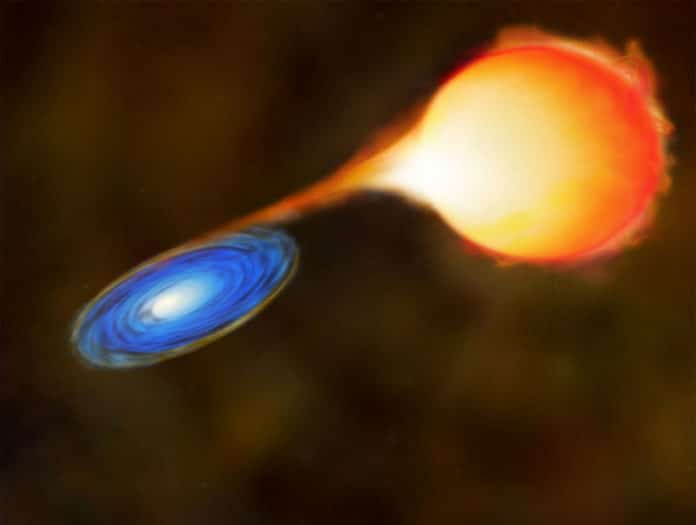Our Milky Way galaxy consists of several red giant stars. For some time, astronomers have predicted the existence of slimmer red giants. Only around 40 stars exist amid a sea of thousands in the Milky Way.
The University of Sydney team has now confirmed their existence after discovering a sprinkling of them.
For the first time, Astronomers have identified a new, slimmer type of red giant star that has lost most of its weight due to a greedy stellar companion.
Lead author, Ph.D. candidate Mr. Yaguang Li from the University of Sydney said, “It’s like finding Wally. We were extremely lucky to find about 40 slimmer red giants hidden in a sea of normal ones. The slimmer red giants are either smaller in size or less massive than normal red giants.”
How did these giant stars undergo dramatic weight loss?
Most of the stars exist in binary systems. When the stars in close binaries expand, as stars do as they age, some material can reach the gravitational sphere of their companion and be sucked away. While talking about red giants, there might be a companion present.
Scientists looked at data from NASA’s Kepler satellite telescope that had been archived. The telescope continually recorded brightness fluctuations on tens of thousands of red giants from 2009 to 2013. The team conducted a full census of this star population using this extraordinarily accurate and extensive dataset, laying the framework for finding any outliers.
They found two types of unusual stars: very low-mass red giants and underluminous (dimmer) red giants. The very low mass giants weigh only 0.5 to 0.7 solar mass. On the other hand, the underluminous stars have normal masses, ranging from 0.8 to 2.0 solar mass.
Mr. Li said, “If the very low-mass stars had not suddenly lost weight, their masses would indicate they were older than the age of the Universe – an impossibility.”
“When we first obtained the masses of these stars, we thought there was something wrong with the measurement. But it turns out there wasn’t.”
Study co-author Dr. Simon Murphy from Southern Queensland said, “The underluminous stars are much less giant than we expect. They’ve slimmed down somewhat, and because they’re smaller, they’re also fainter; hence ‘underluminous’ compared to normal red giants.”
“Only seven such underluminous stars were found, and the authors suspect many more are hiding in the sample. The problem is that most of them are very good at blending in. It was a real treasure hunt to find them.”
Simple stellar evolution predictions could not account for these unique data values. This led the scientists to believe that another mechanism is at work, causing these stars to lose a significant amount of mass: mass theft by surrounding stars.
To determine the properties of red giants, scientists relied on asteroseismology.
Mr. Li said, “Traditional methods to study a star are limited to their surface properties, for example, surface temperature and luminosity. By contrast, asteroseismology, which uses sound waves, probes beneath this. The waves penetrate the stellar interior, giving us rich information on another dimension.”
Using this method, scientists could precisely determine stars’ evolutionary stages, masses, and sizes with this method. They noticed something unusual while observing their properties: some stars have tiny masses or sizes.
Professor Tim Bedding, Mr. Li’s academic supervisor, said, “It is highly unusual for a Ph.D. student to make such an important discovery. By sifting carefully through data from NASA’s Kepler space telescope, Yaguang spotted something that everyone else had missed.”
Journal Reference:
- Li, Y., Bedding, T.R., Murphy, S.J. et al. Discovery of post-mass-transfer helium-burning red giants using asteroseismology. Nat Astron (2022). DOI: 10.1038/s41550-022-01648-5
